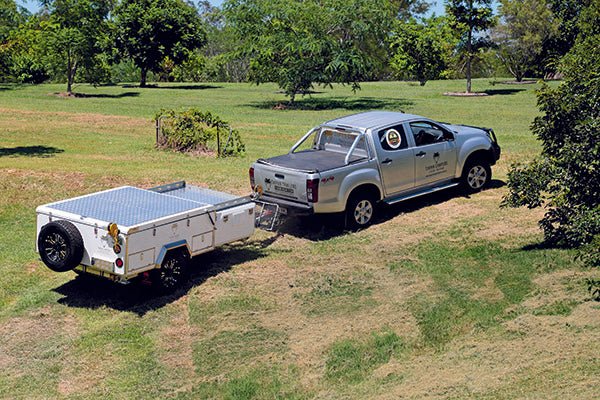
Taipan Pegasus Review
|
|
Time to read 4 min
|
|
Time to read 4 min
Like many of its contemporaries, Brisbane-based Taipan Trailers has various camper trailer styles in its range, including side-fold, rear-fold and forward-fold models. That way, the company doesn’t have to extol the advantages of one particular style over another, merely the overall benefits of its product line.
That might sound like marketing 101 but, for buyers, it makes it easier to compare campers side-by-side and ponder which style suits their needs. For this test, we did more than look – we hooked up the Taipan Pegasus forward-fold and towed it out the door!
The Pegasus on review has an overall length of 5.3m and a Tare weight of 1350k, making it relatively light. The towball weight, however, at 175kg is not a light load, but the trailer still behaved well behind our Isuzu ute tow tug.
With an ATM of 1950kg, the trailer has a more-than-adequate load capacity of 600kg and, if you keep your load to a minimum, a smaller tow vehicle may suffice, but you’ll need to check the loaded ball weight before setting off. If it’s excessive, then some weight distribution will need to happen.
The foundations of all Taipan camper trailers are built in China, including the body, chassis and drawbar components, with much of the final assembly work done in Australia. I think this makes a lot of sense as, logistically, it’s much easier to keep an eye on the ball locally when it comes to maintaining quality control.
A look under the Pegasus reveals a hot-dipped galvanised chassis with 70x50mm main rails and 100x50mm drawbar rails. At the rear, a 120L stainless steel water tank with alloy checkerplate protection sits between the rails.
Even with the water tank, there is still a generous amount of ground clearance helped, in part, by the alloy wheels and 265/70 R16 tyres, fitted to the independent trailing arm, coil spring and twin shock absorber suspension. I was pleased to see that all the essential, but vulnerable, items were mounted well out of harm’s way, including the four corner stabilisers.
Like many other forward-fold campers I’ve seen, the Pegasus has an extended drawbar (1.4m) with the storage boxes up front. In this instance, there’s enough space to store two gas cylinders and two jerry cans in the holders behind the stone protector. You’ll also find the jockey wheel, 2000kg-rated poly-block coupling and hand winch at the pointy end.
Above the chassis, the Pegasus features a powder-coated steel body finished in stand-out white. Both the top of the main camper body and the forward storage bins have a protective alloy checkerplate cover, with a useful storage rack above the front bins.
When you’re travelling between campsites, it’s easy to see how much of the Pegasus trailer can be used without actually opening out the tent. At the rear of the trailer, a stainless steel kitchen bench slides out, offering a three-burner cooktop, sink and drainer and 12V pumped water. Up front, the larger compartment comes with a slide-out for an icebox or chest-style fridge, a large drawer which can accommodate all kind of cooking essentials and a shelf above.
On the opposite side, the drawbar storage box offers two good-size drawers, the 95A deep cycle battery and the 12V electrical control panel complete with fuses and circuit switches. At the rear of the trailer, the offside bin gives some storage space plus access to the water tank filler.
Having a mechanical winch on either end of the trailer makes opening and closing the camper quite simple, although it’s still easily done by hand. The main tent area comes with a tropical roof and canvas awnings above each window, except for those under the awning. The 4280x2400mm awning adds a considerable amount of under canvas that easily covers the entire kitchen. In addition to the external hoods, all the windows have internal canvas flaps.
Similar to other forward-fold designs I’ve seen, the 1920x1600mm bed is in the front and there’s a U-shaped lounge at the rear. Given the trailer profile, the lounge is set fairly low, as is the folding table that sits between the lounge seats. The table can be lowered and, along with a couple of seat cushions, used to create a second bed for guests, kids or just lounging around. It’s worth noting the four drawers under the seats, which I find much easier to use than fiddling around with plywood under the cushions.
Also fitted under the seats are a couple of 12V sockets, while the internal tent frame makes an ideal location for mounting LED strip lighting. A third 12V outlet is located by the slide-out kitchen. Other than that, the electrics are quite simple, with the battery’s only charging source being an Anderson plug.
The Pegasus is not wired for 240V, which means there is no mains charger nor is there an easy direct connection for a generator. Therefore, if you’re planning on spending time camped up, especially with a fridge in the slide, an alternative charging source like portable solar panels or a generator with a 12V charger will be required to keep the battery maintained.
Electronic devices such as laptops, tablets or mobile phones will also need a compatible cable if they’re to be charged from a 12V source at camp.
In its base form, the Pegasus camper comes at an affordable price and can be used more or less straight after driving from the warehouse floor. But it would benefit from some owner additions such as an external shower unit or a more sophisticated electrical system. It is designed for offroad use and comes well-equipped for that purpose.